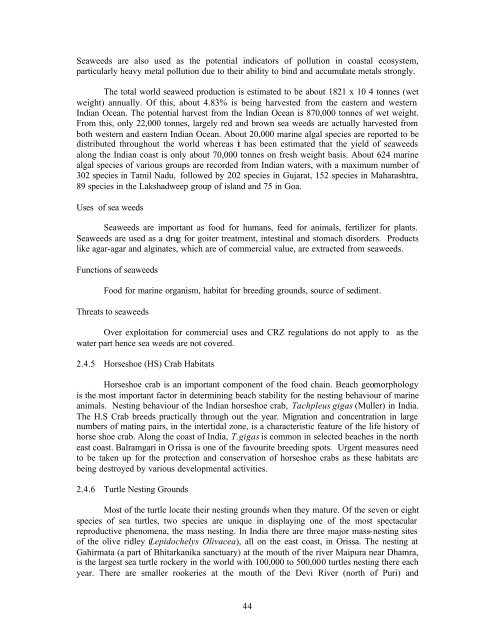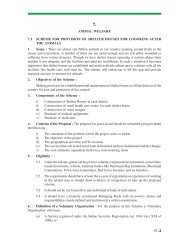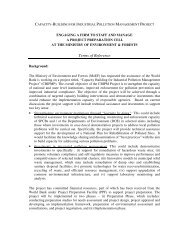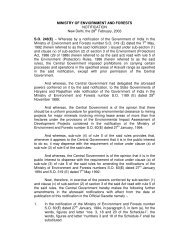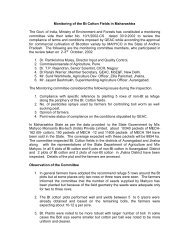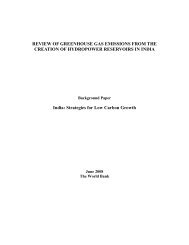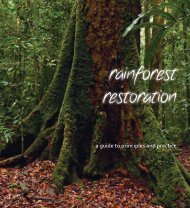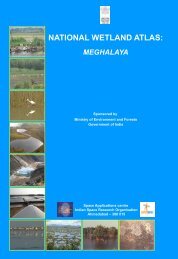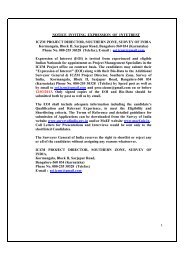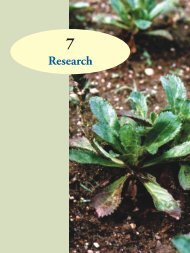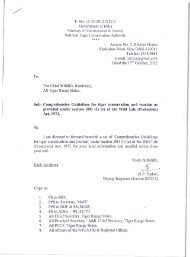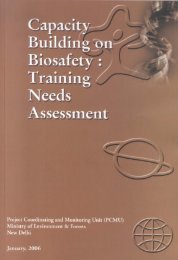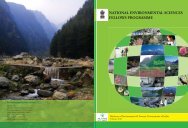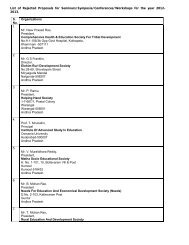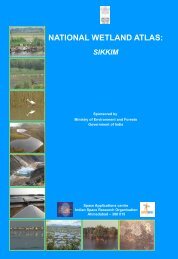pdf - Ministry of Environment and Forests
pdf - Ministry of Environment and Forests
pdf - Ministry of Environment and Forests
- TAGS
- ministry
- forests
- moef.nic.in
You also want an ePaper? Increase the reach of your titles
YUMPU automatically turns print PDFs into web optimized ePapers that Google loves.
Seaweeds are also used as the potential indicators <strong>of</strong> pollution in coastal ecosystem,<br />
particularly heavy metal pollution due to their ability to bind <strong>and</strong> accumulate metals strongly.<br />
The total world seaweed production is estimated to be about 1821 x 10 4 tonnes (wet<br />
weight) annually. Of this, about 4.83% is being harvested from the eastern <strong>and</strong> western<br />
Indian Ocean. The potential harvest from the Indian Ocean is 870,000 tonnes <strong>of</strong> wet weight.<br />
From this, only 22,000 tonnes, largely red <strong>and</strong> brown sea weeds are actually harvested from<br />
both western <strong>and</strong> eastern Indian Ocean. About 20,000 marine algal species are reported to be<br />
distributed throughout the world whereas it has been estimated that the yield <strong>of</strong> seaweeds<br />
along the Indian coast is only about 70,000 tonnes on fresh weight basis. About 624 marine<br />
algal species <strong>of</strong> various groups are recorded from Indian waters, with a maximum number <strong>of</strong><br />
302 species in Tamil Nadu, followed by 202 species in Gujarat, 152 species in Maharashtra,<br />
89 species in the Lakshadweep group <strong>of</strong> isl<strong>and</strong> <strong>and</strong> 75 in Goa.<br />
Uses <strong>of</strong> sea weeds<br />
Seaweeds are important as food for humans, feed for animals, fertilizer for plants.<br />
Seaweeds are used as a drug for goiter treatment, intestinal <strong>and</strong> stomach disorders. Products<br />
like agar-agar <strong>and</strong> alginates, which are <strong>of</strong> commercial value, are extracted from seaweeds.<br />
Functions <strong>of</strong> seaweeds<br />
Food for marine organism, habitat for breeding grounds, source <strong>of</strong> sediment.<br />
Threats to seaweeds<br />
Over exploitation for commercial uses <strong>and</strong> CRZ regulations do not apply to as the<br />
water part hence sea weeds are not covered.<br />
2.4.5 Horseshoe (HS) Crab Habitats<br />
Horseshoe crab is an important component <strong>of</strong> the food chain. Beach geomorphology<br />
is the most important factor in determining beach stability for the nesting behaviour <strong>of</strong> marine<br />
animals. Nesting behaviour <strong>of</strong> the Indian horseshoe crab, Tachpleus gigas (Muller) in India.<br />
The H.S Crab breeds practically through out the year. Migration <strong>and</strong> concentration in large<br />
numbers <strong>of</strong> mating pairs, in the intertidal zone, is a characteristic feature <strong>of</strong> the life history <strong>of</strong><br />
horse shoe crab. Along the coast <strong>of</strong> India, T.gigas is common in selected beaches in the north<br />
east coast. Balramgari in O rissa is one <strong>of</strong> the favourite breeding spots. Urgent measures need<br />
to be taken up for the protection <strong>and</strong> conservation <strong>of</strong> horseshoe crabs as these habitats are<br />
being destroyed by various developmental activities.<br />
2.4.6 Turtle Nesting Grounds<br />
Most <strong>of</strong> the turtle locate their nesting grounds when they mature. Of the seven or eight<br />
species <strong>of</strong> sea turtles, two species are unique in displaying one <strong>of</strong> the most spectacular<br />
reproductive phenomena, the mass nesting. In India there are three major mass-nesting sites<br />
<strong>of</strong> the olive ridley (Lepidochelys Olivacea), all on the east coast, in Orissa. The nesting at<br />
Gahirmata (a part <strong>of</strong> Bhitarkanika sanctuary) at the mouth <strong>of</strong> the river Maipura near Dhamra,<br />
is the largest sea turtle rockery in the world with 100,000 to 500,000 turtles nesting there each<br />
year. There are smaller rookeries at the mouth <strong>of</strong> the Devi River (north <strong>of</strong> Puri) <strong>and</strong><br />
44


